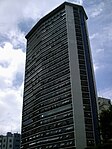Largo do Arouche

Largo do Arouche, also known as Flower Square (Portuguese: Praça das Flores) or Flower Market (Mercado das Flores), is located in the República district, in the central region of the city of São Paulo. It represents a center of diversity, as it has been occupied by LGBTQIAP+ social groups since the 1940s, an occupation that resisted the military dictatorship in the fight for the right to sexual and gender diversity. It houses several florists who set up shop after the existing stalls in República Square were removed by Mayor Armando de Arruda Pereira around 1914. During the 1900s, it housed the Arouche Free Fair, which was created during the crisis in the supply of fruit and vegetable products and closed in 1954. The current name refers to Lieutenant General José Arouche de Toledo Rendon, the first director of the Law School of the University of São Paulo and the Botanical Garden. It has been called Largo do Ouvidor, Largo da Artilharia and Alexandre Herculano Square. The place became nationally known after the sitcom Sai de Baixo, produced by TV Globo, was launched. The series, shown between 1996 and 2002, portrayed humorous situations that took place in a fictitious building located in Largo do Arouche.
Excerpt from the Wikipedia article Largo do Arouche (License: CC BY-SA 3.0, Authors, Images).Largo do Arouche
Avenida Duque de Caxias, São Paulo Campos Elísios (Santa Cecília)
Geographical coordinates (GPS) Address Nearby Places Show on map
Geographical coordinates (GPS)
| Latitude | Longitude |
|---|---|
| N -23.540833333333 ° | E -46.646388888889 ° |
Address
Avenida Duque de Caxias 80
01214-000 São Paulo, Campos Elísios (Santa Cecília)
São Paulo, Brazil
Open on Google Maps









